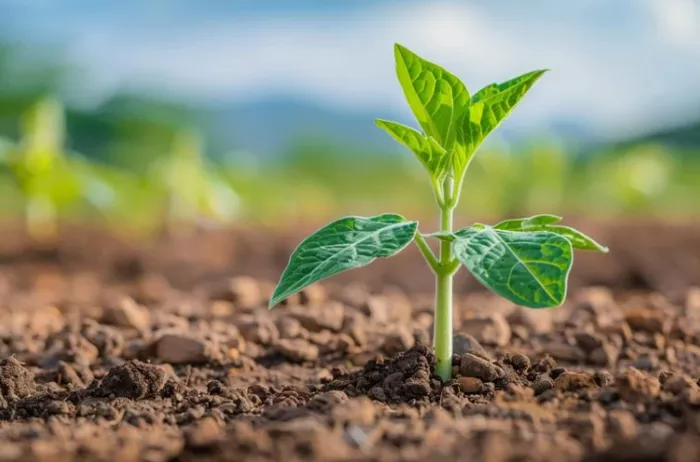MIT researchers are pioneering new agricultural technologies aimed at mitigating the effects of climate change and improving global food security. Among the innovations being developed are stress-detecting plants, microbial fertilizers, and protective seed coatings designed to help crops thrive under increasingly harsh environmental conditions.
As global temperatures rise, farming faces new challenges, including more frequent droughts and the loss of arable land. Furthermore, feeding the growing global population is becoming more difficult without relying on fertilizers and agrochemicals, which contribute significantly to carbon emissions and global warming.
To address these issues, MIT scientists are exploring a range of solutions, such as creating plants that can signal when they are under stress and developing more drought-resistant seeds. These innovations are expected to play a key role in ensuring food production can meet the demands of a changing climate.
According to Benedetto Marelli, an associate professor of civil and environmental engineering at MIT, “After water, the first thing we need is food. As we work to support a world of 10 billion people, it will require inventing new ways to produce food.”
Marelli, who directs the “Wild Cards” mission under MIT’s Climate Project, focuses on finding high-risk, high-reward solutions for critical issues like decarbonizing industry and building resilient cities. He believes that MIT’s cross-disciplinary approach, which includes expertise in engineering, biology, and economics, is essential to solving the climate crisis.
Protecting Seeds and Enhancing Crop Resilience
Marelli, originally a biomedical engineer, is working to increase crop yields by developing ways to help seeds survive in drought-stricken or nutrient-poor soil. His team has created seed coatings made from silk and other polymers that provide vital nutrients and protect seeds during the crucial germination phase.
In normal, healthy soil, crops receive necessary nutrients from microbes. However, soil impacted by drought or over-farming often lacks these nutrients. Marelli’s solution involves coating seeds with a biopolymer embedded with nitrogen-fixing bacteria that can absorb nitrogen from the air and make it available to plants. The microbes can also provide other essential nutrients.
The team’s seed coatings, which have been successfully tested for their ability to protect seeds from drought, UV exposure, and high salinity, are now being adapted for use with crops in Morocco. There, researchers are using a biopolymer derived from food waste, a material locally available and more sustainable than silk.
“We’re working with local communities in Morocco to create a solution that fits their needs and environment,” says Marelli. “The key is to match our technology with the ingenuity and resources available in the local context.”
Microbial Fertilizers: A Sustainable Alternative
The heavy use of synthetic fertilizers is another major environmental issue. The energy-intensive production process, known as the Haber-Bosch process, accounts for a significant portion of global greenhouse gas emissions. Ariel Furst, an MIT chemical engineering professor, is developing a microbial alternative to traditional fertilizers.
Instead of synthetic fertilizers, Furst’s research focuses on nitrogen-fixing bacteria, which can be applied directly to crops to provide essential nutrients. However, the challenge lies in preserving and transporting these microbes, which are fragile and difficult to store.
Furst and her team have developed a way to encase these microbes in a protective shell made from a metal-organic compound, preventing damage during storage and transport. This coating allows the bacteria to survive heat, freeze-drying, and other stresses, making it easier to deploy them on farms.
“These microbes could be delivered with the seeds, reducing the need for mid-growth fertilization and cutting costs for farmers,” says Furst. “It’s a more sustainable approach that can also improve soil health and boost crop yields.”
Furst’s company, Seia Bio, is already testing the coated microbes on farms in Brazil and is working to adapt them for capturing carbon dioxide from the atmosphere, potentially turning it into limestone to help improve soil pH.
Plants as Distress Sensors
MIT chemical engineering professor Michael Strano is exploring the idea of using plants themselves as sensors to detect stress. Plants release signaling molecules when they face drought, pests, or other challenges. Strano’s team has developed sensors that can be inserted into plant leaves to detect these signals in real-time.
These sensors, which use carbon nanotubes and can detect molecules like salicylic acid and hydrogen peroxide, emit fluorescent light when they pick up stress signals. Farmers can use infrared cameras to monitor these signals and take action before crop damage occurs.
Strano’s team has tested the sensors in controlled environments in Singapore and sees potential for widespread use in both field agriculture and controlled environments like greenhouses. The goal is to provide farmers with timely data to improve crop yields and reduce losses.
Reducing Pesticide Use and Waste
Pesticides are another significant cost and environmental issue for farmers, with global pesticide spending reaching $60 billion annually. MIT mechanical engineering professor Kripa Varanasi is developing technologies to improve pesticide application, reducing waste and minimizing the environmental impact.
Varanasi’s team has designed a system that helps pesticides adhere better to plant surfaces, reducing runoff into soil and water. By adding surfactants to pesticides, they have created a formula that allows the droplets to stick to leaves more effectively.
In 2020, Varanasi and his colleague Vishnu Jayaprakash founded AgZen, a company focused on commercializing these technologies. One product, RealCoverage, uses machine vision to provide real-time data on how much pesticide adheres to plants, allowing farmers to optimize application and reduce pesticide use by up to 50%.
“Our goal is to help farmers save money while improving yields and reducing environmental harm,” says Varanasi. “We’re providing farmers with the tools to use pesticides more efficiently and sustainably.”
The Future of Agriculture
MIT’s innovative technologies offer promising solutions to some of the most pressing challenges facing agriculture today. From drought-resistant seeds to microbial fertilizers and real-time plant sensors, these advancements could help create more sustainable farming practices, ensuring food security for future generations in the face of climate change.
Related topics:


